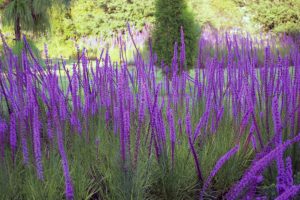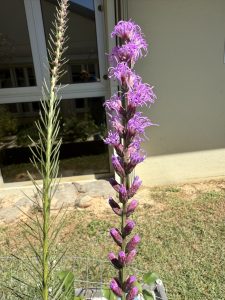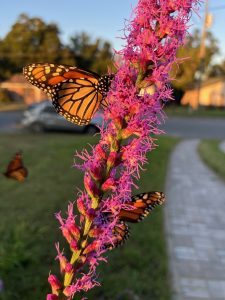
A spectacular array of blazing star in bloom. Photo credit: Troy Springer, Florida Wildflower Foundation
Walking through a northwest Florida wildflower prairie in autumn, the star of the show is Liatris. Known as dense gayfeather or blazing star, this tall (up to 7’!) stunner of a plant is covered up with clusters of small purple flowers. The flowers are are composed of tiny, frilly five-petaled florets. Each cluster may have groups of up to 18 flowers at a time, crowding the stalk with color.
Before blooming, the spiky grasslike structure grows upright and produces a series of dozens of green leaflets, similar in form to rosemary.
While delicate in appearance, the blazing star is a hardy plant adapted to a wide range of habitats. Some varieties can grow in the pure sand of beach dunes and scrub, while Liatris spicata thrives in the soggy wet soils of bogs and pine flatwoods. The species is known for attracting bees, butterflies, and hummingbirds, so it makes a great addition to a pollinator garden. The flowers perform best in full sun.

Side-by-side, the bottlebrush-like blazing star plant before and after blooming. Photo credit: Carrie Stevenson, UF IFAS Extension
Blazing star is particularly impressive in a large group, so you can plant dozens together (by seed or container) for a beautiful effect. After blooming deep purple this time of year, they’ll turn a goldish bronze that adds to the interesting fall color of a garden. Liatris will also re-seed every year after dying back in the winter.
There are many plants native to the United States known commonly as colic root, including blazing star. This nickname arose from its traditional medicinal use treating stomach cramps. Additional uses of a tea made from the plant were used for everything from sore throats and kidney issues, while an incense made from dried roots was burned for sinus relief.
- Yucca–A Tough and Versatile Native Plant - November 26, 2025
- Blazing Star - November 6, 2025
- University of West Florida’s New Heritage Roots Garden - October 17, 2025

